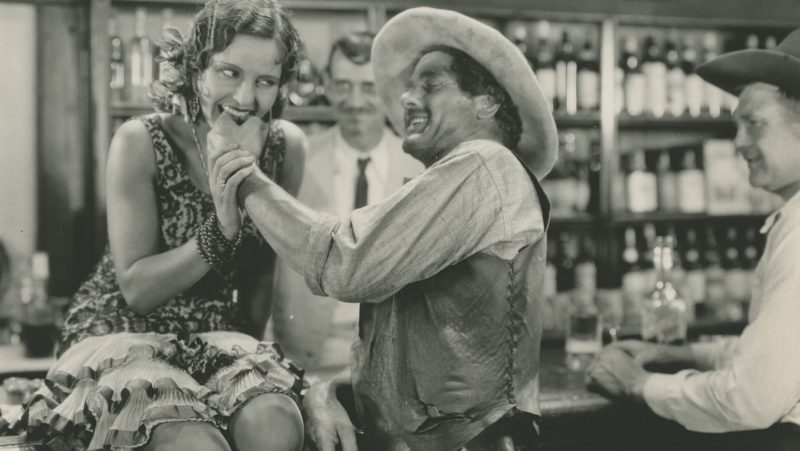ALSO CELEBRATED ARE HARRY CAREY, HARRY PIEL AND SONIA DELAUNAY
SYD CHAPLIN, MARCEL FABRE AND EMIL ARTUR LONGEN
IN TODAY’S SLAPSTICK PROGRAMME “LIFE’S A DRAG”
The Canon Revisited section, curated by Paolo Cherchi Usai with the aim of ensuring younger generations are exposed to the great classics, plays host to Hell’s Heroes, screening in Pordenone after a gap of nearly thirty years since it was last presented at the festival in 1994. Director William Wyler was born in Alsace in 1902, moving to America after his mother contacted her cousin, Universal Studios owner Carl Laemmle, who offered his young relative a job in New York. Wyler quickly lived up to expectations and from the age of 22 began a formidable career as a director that included legendary films and three Oscars (Mrs. Miniver, The Best Years of Our Lives and Ben-Hur). By 1929 Wyler had already directed a great number of shorts as well as a few features, but most were quickly and cheaply made though already characterized by excellent workmanship. Hell’s Heroes is his first truly mature film, stamped with his personal vision and clearly demonstrating his desire to break away from the mold of conventional Westerns. It’s a dark story, of three robbers who find a child in the middle of a desert and, almost against their nature, sacrifice their lives to bring the baby to safety. Not since Stroheim’s Greed had the frightening atmosphere of the Western desert been brought to the screen with such raw realism. Hell’s Heroes was shot in both silent and sound versions, to accommodate theatres that had yet to make the transition to the new medium; the Giornate is screening the silent version, with piano accompaniment by John Sweeney on Sunday, October 8th at 9pm.
The Harry Piel retrospective kicks off at 3.30 PM this afternoon with Erblich Belastet? (roughly translated as Predestined from Birth?, 1913), the earliest surviving title directed by this pioneering filmmaker who became the Weimar Republic’s box office king thanks to his feats of daredevilry. During the silent period he directed approximately ninety films and amassed a global fan base for his breakneck chases and climactic stunts; the festival is screening eight films, most of which are recent restorations presented as world premieres. Today’s film comes from the period before he acted, when he was only directing and producing, and stars Ludwig Trautmann.
The day’s screenings begin at 9 AM with the first episode of the six-part serial Le P’tit Parigot, part of the retrospective dedicated to Sonia Delaunay, the Ukrainian-born multi-faceted artist closely associated with the Paris avant-garde scene of the 1920s. While her work in cinema lasted just a few years, her bold designs for costumes and textiles were perfectly attuned to cinema’s love affair with Art Deco. Le P’tit Parigot showcases her bold pictorial strategies alongside those of her husband Robert Delaunay and other major figures in the Parisian Modernist art scene.
The morning program starting at 11 AM is the second and final installment in the Harry Carey tribute, consisting of the Westerns Blue Streak McCoy (1920) by B. Reeves Eason and The Fox (1921), Universal’s first “Super-Western,” directed by Robert Thornby.
Today’s theme in the retrospective devoted to the fertile relationship between European and American slapstick is “Life’s a Drag,” featuring Syd Chaplin’s rarely seen Oh! What a Nurse from 1926, the third and last screen drag role for Charlie Chaplin’s half-brother, who excelled in playing comical cross-dressing characters. Also involved in the making of the movie was Syd Chaplin’s frequent director, Charles Reisner, and future Hollywood tycoon Darryl F. Zanuck as screenwriter. Also showing in the 5 PM program is La Signora Robinet, a 1913 Ambrosio production from the Museo Nazionale del Cinema di Torino, starring Manuel Fernández Peréz, better known as Marcel Fabre; and Rudi na Záletech (“Rudy the Butterfly”) from 1911, a Czech production from when the country was part of the Austro-Hungarian Empire. Director, screenwriter and protagonist Emil Artur Longen was a multifaceted genius also active in literature, painting and theatre, and shot this raucous short on location in Prague; its plot and chase sequences anticipate Mack Sennett’s American beach comedies à la Keystone.
As per tradition, the afternoon opens with the musical notes of local school orchestras who’ve been rehearsing all year to perform before the festival’s international audience of connoisseurs. Beginning at 2.30 PM, students from the Istituto Comprensivo Rorai Cappuccini and the Istituto Comprensivo Pordenone Centro pay homage to Walt Disney on his centenary by accompanying two shorts from the Alice Comedies series, Alice Solves the Puzzle (1925) and Alice the Whaler (1927), while students from the orchestra of the Liceo Musicale Marconi of Conegliano accompany Harry H. Williams’ 1915 short The Great Vacuum Robbery, in which the protagonists rob a bank with a vacuum cleaner. Conceived by Maria Luisa Sogaro and now in its sixteenth edition, the “Striking a New Note” project is curated by the Cinemazero Media Library in collaboration with the Cineteca del Friuli, which provided the films chosen by the young people.
The Pordenone Silent Film Festival / Le Giornate del Cinema Muto is made possible thanks to the support of the Regione Autonoma Friuli Venezia Giulia, the Ministry of Culture — Direzione Generale Cinema, the city of Pordenone, the Pordenone-Udine Chamber of Commerce and the Fondazione Friuli.


 Italiano
Italiano
Recent Comments